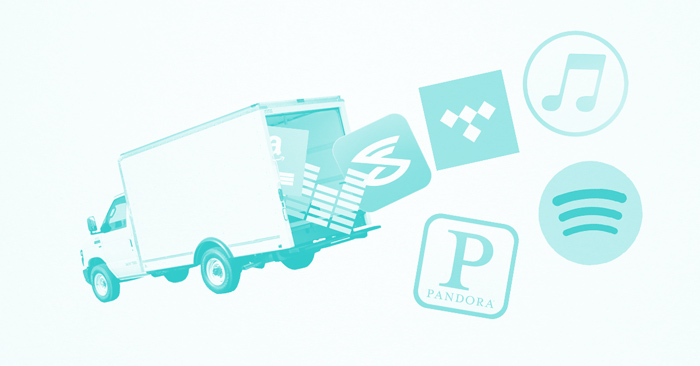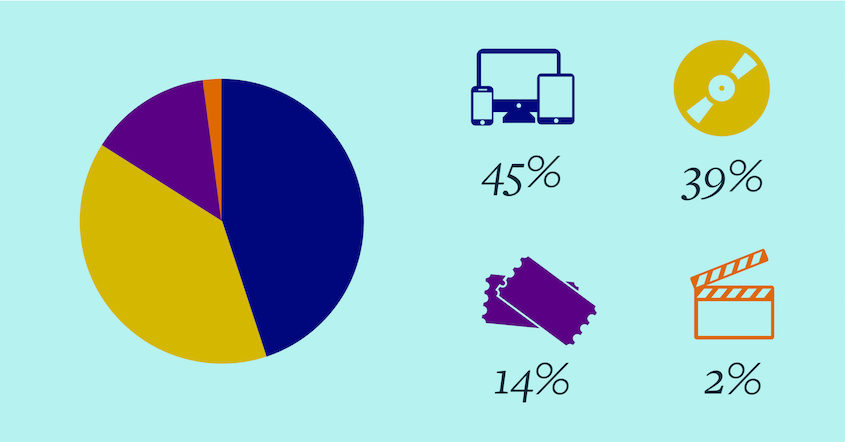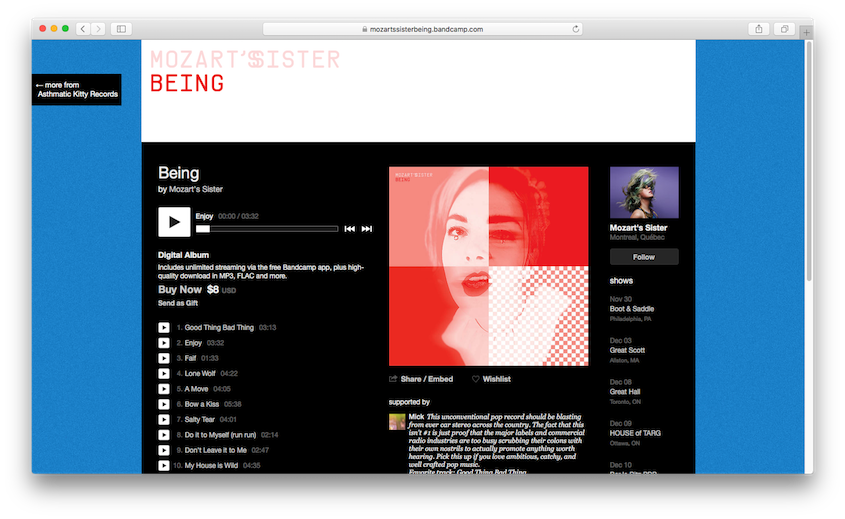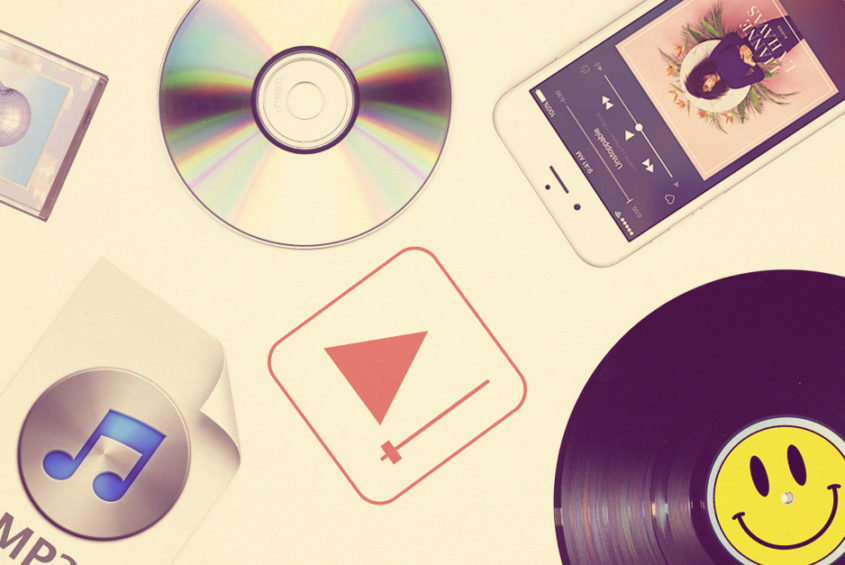With brick and mortar music stores no longer being the only (or even best) way for artists to get their music into the hands of fans, the distribution process has changed significantly. Here we offer a concise guide on how artists can make digital distribution work for them.
_____________________________
Guest Post by Leticia Trandafir on Landr
Music distribution is the link between your finished record and your future fans.
Distribution is a crucial part of music promotion. Brick and mortar music distributors used to be the only way for record labels and independent artists to get their records in the hands of listeners.
But digital music distribution has taken the center stage. Digital surpassed sales of physical mediums for the first time in 2015.
As an artist, digital distribution has become a must in order to reach all your potential fans. Smart distribution grows your visibility. It gets your music into as many ears as possible. And it helps you get paid for your music.
So here is everything you need to know about digital music distribution and how to do it right.
HOW MUSIC DISTRIBUTION WORKS: THEN AND NOW
Traditionally, distributors got records into stores and labels got people to go buy them (through promotion). Along the way, each of these middlemen took a percentage of the revenue.
This system still exists today. At least to some extent…
But the role of distributors and record labels has changed dramatically. Not to mention the changes the internet has brought in the way people consume music. People spend more time online, and less money on physical music.

Plus, the resources and energy of physical distributors are often focused on top-selling records only. Smaller bands who sign to them get trapped in exclusive agreements that end up hindering their success.
That’s why digital distribution has become the smart way to get your records out there, keep full rights to your music, and start building a name.
WHAT IS DIGITAL MUSIC DISTRIBUTION?
Digital distribution is making your tracks available through online retailers (iTunes, Amazon, Google Play, etc.) and subscription-based streaming platforms like Spotify, Apple Music, Tidal and others.
The goal of digital distribution is the same as physical distribution: getting your record heard and receiving money or royalties in exchange.
But the move to digital has taken away the need for a lot of annoying in-between steps (warehouse storage, delays, middlemen, breakage, etc.). More artists also have access to distribution because you don’t have to be signed to a label.
Online distributors allow you to distribute your music on all the popular music platforms (iTunes, Spotify, Amazon, etc) quickly and easily.
The main digital music distribution companies today are:
- CD Baby
- TuneCore
- Ditto Music
- Loudr
- MondoTunes
- Reverbnation
- Symphonic
- The Orchard (they work with labels only)
- Awal (selected applications only)
More about choosing your digital distributor below, read on!
THE MANY BENEFITS OF DIGITAL DISTRIBUTION
Why choose digital distribution?
Digital music sells the best, and will continue to rise. The revenues of the music industry make it clear – digital is the way to go. Here are the global revenues of the industry in 2015:
- 45% from digital revenues
- 39% from physical format sales (CDs, vinyl, cassettes)
- 14% from performance rights (radio, shows, etc)
- 2% from Synchronization revenues (movies and ad syncs)

So be strategic. Make your music available where your fans actually hang out:online. You’ll have more chance of reaching them.
Save yourself the costs and hassle of physical distribution – especially on a first album. Start by building an audience and a name with digital releases.
Plus, many digital distributors don’t have exclusivity deals. It means that you’re not giving up the rights to your music. That’s huge. Because if your next record is better represented by another distributor, you’re free to end the non-exclusive agreement anytime.
There’s also added perks like recommendation algorithms. These might suggest your tracks to people based on what they listen to. That’s how people discover new music in the digital world!
Ready to jump into distribution? Here are the steps to follow:
1. FIND THE RIGHT DIGITAL DISTRIBUTION PLATFORM
Ok, so your record is ready. You’ve mixed it and mastered it. Your album art is ready to go. You’re excited to get it out.
Now you might be wondering how to get your music on iTunes.
The first step is to find the right online music distribution platform.
GET TO KNOW THE MAJOR DISTRIBUTION PLATFORMS:
TuneCore
TuneCore gets you worldwide digital distribution for albums, singles and ringtones. It also gives you a Music Publishing Administration pack that allows you to get royalties and syncs.
TuneCore will get you on: iTunes, Amazon, Spotify, Google Play, YouTube Music and more.
Our favorite TuneCore feature: the Music Publishing Administration is a one stop shop for licensing your music. Their statistics are among the best to track how your releases are selling.
Check their pricing here.
CD Baby
Go for both digital and physical (CD and vinyl) distribution worldwide with CD Baby. Distribute albums or singles. Also get sync licensing for TV, film, and games.
CD Baby will get you on: iTunes, Amazon, Spotify, Google Play, Apple Music, Tidal, YouTube Music and more.
Our favorite CD Baby feature: The combo between physical and digital distribution gets you a full distro package. They’re the only who collectSoundExchange (Rights Owner) royalties for you (thanks for the tip Ari).
Check their pricing here.
Symphonic
Symphonic distributes your music worldwide. They get all your music marketing, licensing and publishing needs fulfilled. Symphonic does both physical and digital distribution.
Our favorite Symphonic feature: it gets your music on Beatport, especially good for electronic projects.
Check their pricing here.
Bandcamp

Self-release your music and sell it on Bandcamp. Unlike the platforms above, Bandcamp doesn’t put your music on other online stores (iTunes, etc). It’s a stand-alone online store. It lets you sell physical merch or self-release CDs.
Our favourite Bandcamp feature: add a Bandcamp ‘Buy’ link to yourSoundCloud.
Read more about Bandcamp.
TopSpin
Topspin is a digital store and a marketing platform for musicians. It lets you sell your music (physical and digital), your merch and show tickets. Like Bandcamp, this doesn’t put your music on other platforms (iTunes, Spotify, etc). Instead it lets you embed it on your website or Facebook.
Our favorite TopSpin feature: it’s similar to Bandcamp but with the added email feature. Collect your fan’s emails and stay in your touch with them.
Check their pricing here.
CHOOSE THE BEST ONE FOR YOU
Each of these platforms has their own pricing. It’s either:
- a set fee per album/single
- a yearly fee
- a percentage of your record sales (10-25%).
Plan your budget: carefully read each distributor’s pricing plans and terms.
Remember that a distributor is a new professional partnership. Choose the most beneficial one for you. Make sure the distributor fits your needs, your resources, and your goals.
2. MAKE YOUR MUSIC SEARCHABLE
In traditional distribution artists had to submit a ‘one-sheet’. That’s literally one page that contains all the info about your record (artist name, album title, release date, a short bio, genre, etc.)
The equivalent in the digital world is metadata. These are the short descriptions and keywords that make it easy to classify and find something on the web.

Metadata is crucial in digital distribution. All digital distributors ask for this information. That’s how people browse for music online – especially with genre. You want your potential fans to find your music easily.
So when submit your album for digital distribution, include a list of metadata:
- artist name
- title (of album or single)
- the release date
- record label
- track titles
- genre
- composer information
- artist bio
Make it short. Use the most common words. Make it simple and timeless: avoid using trendy words or hashtags. You want people to find your music 30 years from now!
3. PROMOTE PROMOTE PROMOTE
“Your distributor will only be as good as your marketing plans to sell the record. Don’t expect them to do your [promotional] work for you.” – Indie Bible
Make sure you have a realistic budget for your promotion. Distribution companies tend to focus their promotional efforts on top-selling artists.
So do your own thing – create a powerful social media presence and put yourself out there.
Create buzz about your album even before it drops. Post sneak previews of your jam sessions to Instagram. Play a show in your studio and live stream it. Post 30 second previews of your tracks to SoundCloud.
Get your music to as many ears as possible. Use radio play, blogs, shows, word-of-mouth, and any other way you can think of to get your name out there. Send those emails and make those phone calls. There’s no hack around it!
DISTRIBUTION REVOLUTION
Physical distributors are closing their doors. What if that means better alternatives for you?
Digital distribution now gives all artists a chance: “Whether an artist sells 500 albums or 500,000, they should be housed in the same place and treated with the same level of respect” says the A&R for EMPIRE.
Having a solid digital distribution track record is like having a stellar CV. It’ll get you better shows, better visibility and more negotiating power.
Digital distribution is the most direct route to the ears of fans. Do it right! Do it digital!
Leticia is a DJ and music maker with a love for 303 basslines and hangouts at the library. Content Creator at LANDR.